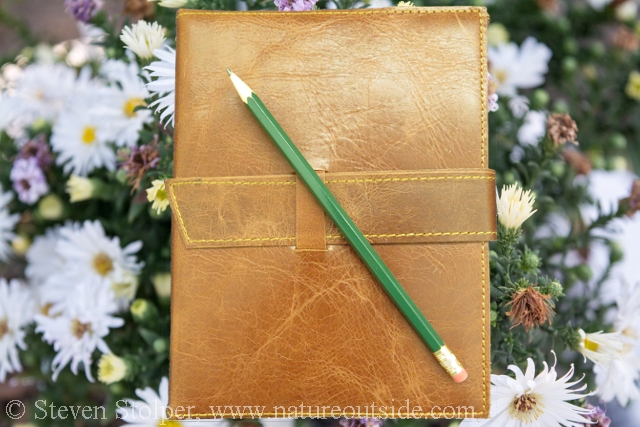
Journaling is like eating broccoli. You know it’s good for you but you just don’t want to do it.
I know because I feel the same way. Imagine how my heart sank when I was told during my first day of naturalist training that I had to keep a journal. I can’t write. I can’t draw. I have the artistic talent of a baloney sandwich. The thought of keeping a journal filled me with dread.
If hiking in nature is milk and cookies, then keeping a journal is broccoli.
I want to share some tips with you that will help you cover your broccoli with ice cream, chocolate syrup, and sprinkles!
5 Reasons Why You Should Journal
There are many reasons you should keep a journal. But here are five of the most important ones.
1. It forces you to be observant – slows down your mind
How often do you see hikers blast through the forest in a blur of motion – arms swinging, walking stick flailing. These hikers are on a mission to get… where exactly?
I was hiking in a high altitude rain forest in Australia. Slowly I crept toward a rare Albert’s Lyrebird, foraging in the leaf litter just yards from the trail. I froze as I heard human voices coming toward me. Darn! The two women approaching me were about to flush this rare bird.
Amazingly the chatting hikers walked just feet from where I crouched, in plain sight, beside the trail. The spectacular lyrebird also remained motionless, gorgeous tail streaming luxuriously behind it. The women passed without even breaking stride.
Keeping a journal forces you to look at your surroundings. I mean really look! When you find a plant or animal, you study it in minute detail because you know you need to capture the experience in your journal. This heightened awareness and attention to detail helps you develop into an outdoorsman who really appreciates the environments you walk through. What are the weather conditions? Have the plants changed? What animals frequent this part of the woods?
The habit of observation is a wonderful practice to cultivate. Becoming more attentive to detail opens new worlds. And keeping a journal helps you do it.
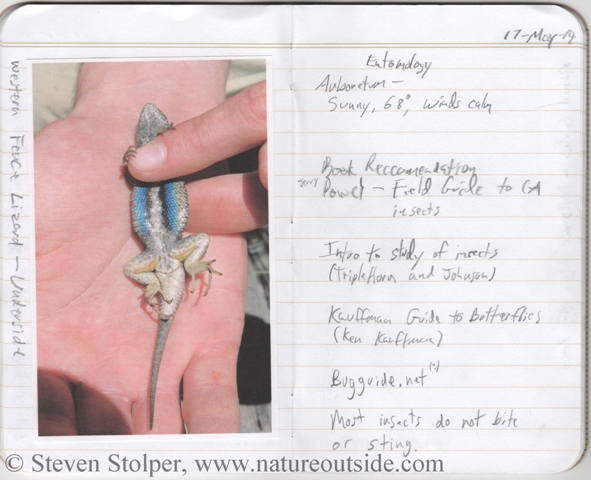
A page from my journal. On the left is the underside of a Western Fence Lizard I captured. This plain looking lizard hides a colorful secret. I pasted a picture of it into my journal. The right-hand page starts a new entry for a walk I did with an entomologist.
2. Record what you’ve learned
I can’t remember what I had for breakfast, much less the flying speed of a Marbled Murrelet (about 50 mph). There is so much to learn about nature that it can be overwhelming. The most important teachers are the plants and animals themselves. Every time I hike I learn or see something new. And I’m not exaggerating – every single time!
I take in much more information than I can commit to long-term memory. So writing it down in my journal serves two functions. I record my new knowledge to review (and relearn) later. And the act of committing it to paper helps me organize and process my newfound information.
I also record what I learn from experts I meet. Whether it’s how to read a lizard tail-drag in the dust or how to make a rawhide rattle, it all goes into my journal.
When you keep a journal, you strengthen and extend your memory. On a stormy day, you can stay out of the weather and review what you learned from past experiences.
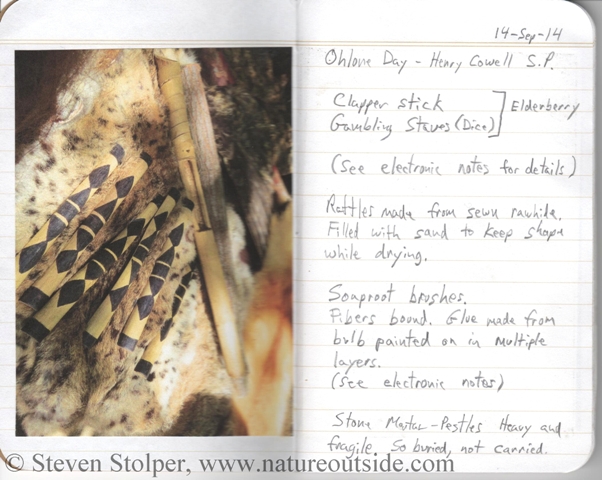
A page from my journal. On the left page I pasted a picture I took of clapper sticks and gambling staves. On the right-hand page I make note of what I’m learning from speaking with the descendants of the Ohlone Peoples.
3. Journaling helps you see patterns
How do the animals around you move? What do they seem to be eating? Do certain plants grow in specific conditions? When you built an atlatl, which woods worked best?
As you move through the woods, your senses constantly absorb new information. But sometimes it’s hard to interpret what we see. Keeping a journal lays it all out in front of you. Journaling helps you organize and interpret what you see to create new knowledge about the world around you.
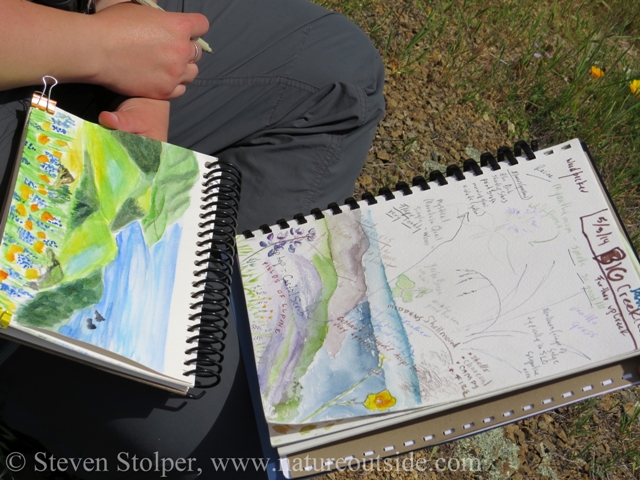
People organize their journals differently. Here are two journals kept by people who use pencils and watercolor pens to record text and graphics on the same page.
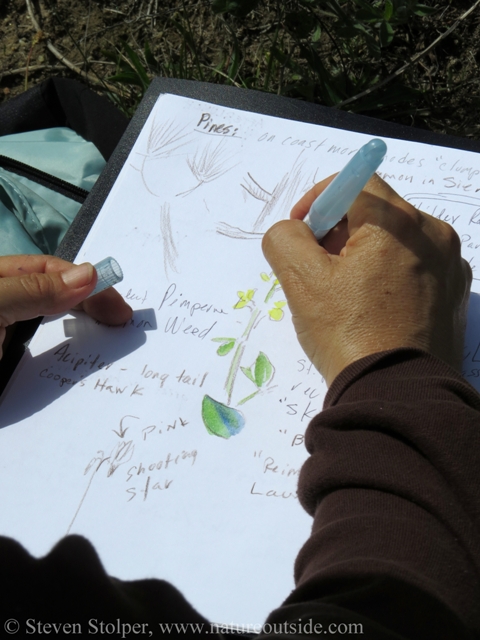
Here is another journal kept by a person who draws and records information on the same page.
4. Your journal helps you locate resources
Where exactly was that elderberry bush? Where were the deer beds you found last time you were on this trail?
There are certain “resident” animals whose homes I pass daily. There are patches of wild edible and medicinal plants I use for food and to treat mild illness. A journal helps me remember the location of these natural resources.
You should also keep this information in your journal. It may be as simple as recording which trail turnoff gives the best view of the valley. Or as complicated as a hand-drawn resource map where X marks the spot.
Either way, journaling helps you remember where you left that bushcraft pot of gold.
5. Catalog your adventures
Journals capture memories. Often I revisit past adventures by reading my journal.
Rereading your journal can bring a flood of memories and feelings. People take vacation pictures all the time. Why?
Imagine the power of being able to recall your outdoor adventures with all the amazing plants and animals you encountered.
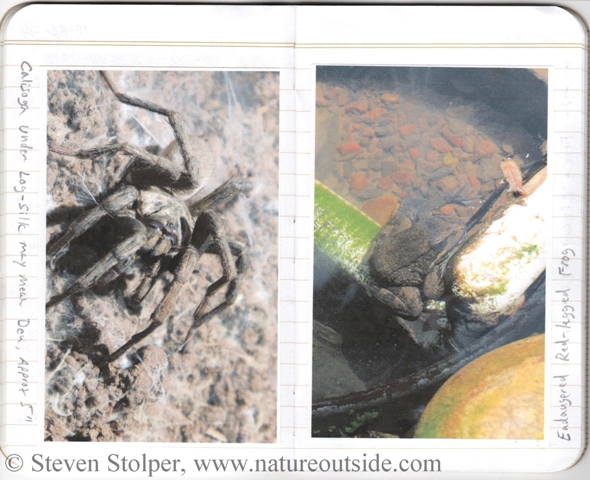
On a single hike I found a Calisoga spider and an endangered Red-legged frog!
Derek Jeter Regrets not Keeping a Journal
Derek Jeter is one of my favorite baseball players. He played 20 seasons in Major League Baseball for the New York Yankees. After retiring he was asked if he had any regrets from his storied career. What did Derek Jeter regret? Not keeping a journal!
During an interview with President Obama, Jeter mentioned how he wished he could have shared his baseball experiences with the children he still hopes to have someday. Although he took notes during his last season in baseball, his biggest regret was not keeping a journal of his career.
I wish I would’ve done that [kept a diary] throughout my career. There are so many experiences that you tend to forget. So if I could go back to 25, I would say, [write in a diary] every day.
– Derek Jeter
What is Nature Journaling?
The essence of journaling is to ask questions and try to answer them. A good journal doesn’t just contain descriptions of what you see. That’s a myth! Good nature journals are richly decorated with questions that make you think deeply about what you see.
Ask questions to ask more questions.
When I was learning to journal, I attended a lecture given by the modern naturalist, John Muir Laws. He advocates following the pattern below when making an entry in your journal.
I notice…
I wonder…
It reminds me of…
– John Muir Laws
The first line prompts you to record your observations. The second, to ask questions. The third line urges you to connect your observations together into patterns that help you gain knowledge.
Biggest Objections
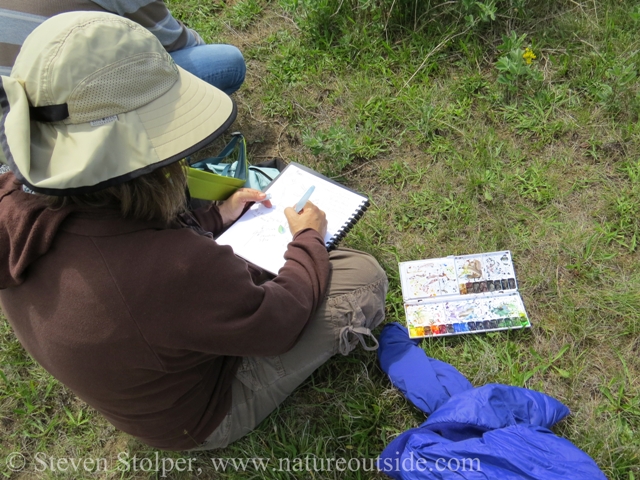
It’s a myth that you must be good at art to keep a journal.
I suck at Art
It’s a myth that you need artistic ability to keep a journal! If you can draw or paint – wonderful! But I suck at art. I will show you in the next section how to use technology to compensate for not being able to draw well.
I suck at writing
Who’s the audience for your journal? You are! So it doesn’t matter if you don’t write well. Put your thoughts on the paper any way you want. All that matters is that what you write is meaningful to you.
You will find that the more entries you make in your journal, the more your writing skills improve. Like anything else, it’s a matter of practice. I tend to write “one liners” that contain facts or observations from the trail. I leave the flowery language to Thoreau.
It’s too hard
No, it’s not. I’ll show you a simple technique in the next section that will permit you to whip-up journal entries in a matter of minutes.
I don’t want to stop hiking
This was my biggest concern. I did not want to interrupt my hike to make a journal entry. I was able to overcome this by selecting my equipment judiciously.
How I Journal
Confession time: I suck at art and I suck at writing. But I do keep a journal. Let me show you how I do it.
The Grinnell System
Joseph Grinnell (1877 – 1939) was an American field biologist and zoologist. He lived near me in California. Grinnell made extensive studies of the fauna of California. But the reason we’re talking about him is his journaling method. Grinnell is credited with introducing a method of recording precise field observations known as the Grinnell System.
It’s really very simple. There is a framework for recording your information, and all you have to do is “fill in the blanks.” You can even set up your journal pages beforehand. Then fill them in when you are in the field.
First, you only write on the right-hand pages. You leave the left-hand pages blank for pictures, maps, and drawings. On the right-hand pages you follow a standard format, which I adapted for my journal entries:
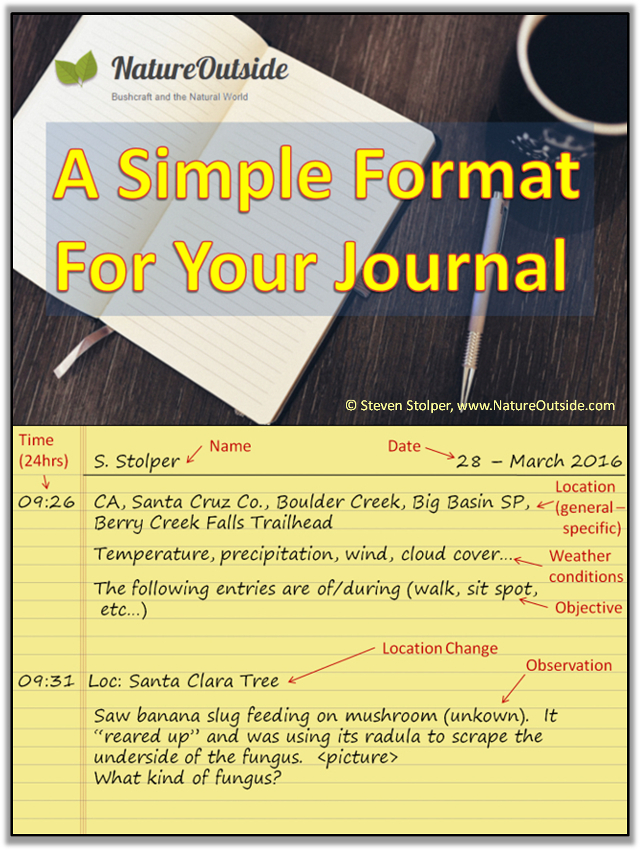
How I keep my journal
My Equipment
All of my equipment fits in a nylon BDU Organizer Pouch that measures about 5 inches x 7.5 inches x 1 inch. It fits in the pocket of my hiking pants. This makes it convenient to whip out my journal whenever I want to make an entry.
Besides a pencil, I keep a tape measure, hand lens, and tongue depressors I use for marking animal tracks.
For my journal, I use a Field Notes Brand 48-page memo book. A set of three costs about $10. They measure only 3.5 inches x 5.5 inches. This is a blessing and a curse. They fit perfectly in my BDU pocket organizer. But the pages are relatively small.
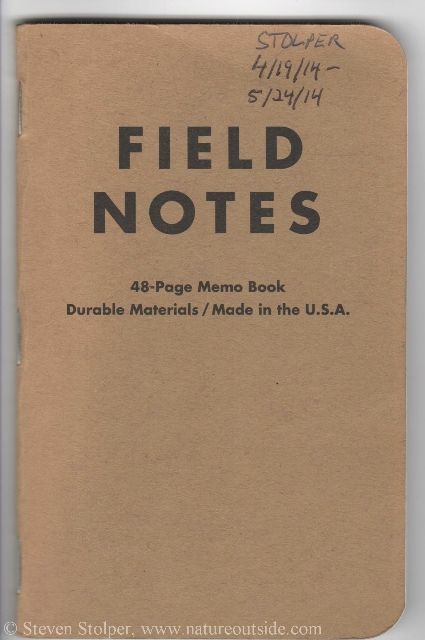
My journal. When I fill it up, I switch it for another. This keeps my journals thin and prevents accidentally losing all my notes.
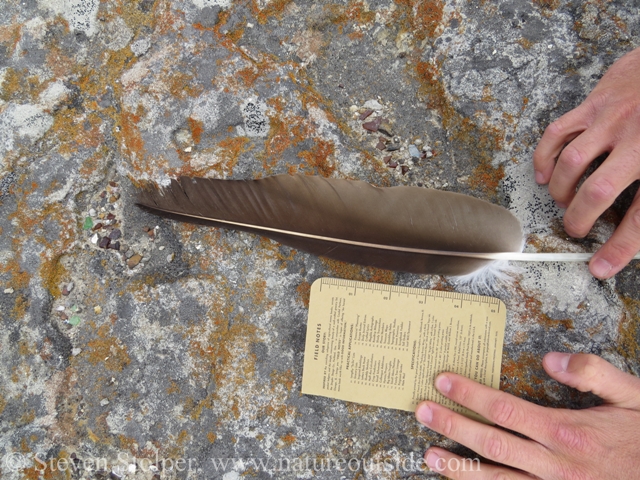
For scale, this amazing feather is over a foot long. I used my “field notes” journal as a ruler.
My technique
At the start of my hike, I capture the big picture (weather, time of day, etc.) in my journal. I frequently use the Grinnell System. But sometimes I just take quick notes (see picture below).
Instead of drawing (did I mention I suck at drawing?), I use my digital camera to take pictures. Admittedly, it doesn’t force me to stop and consider what I’m looking at as much as drawing does. But it is faster and more accurate than drawing. It allows me to stop, capture an image for my journal, and hike on.
When I take pictures, I write in my journal about what I’ve observed. This is when I capture valuable knowledge and insight. It helps me interpret the pictures when I return home.
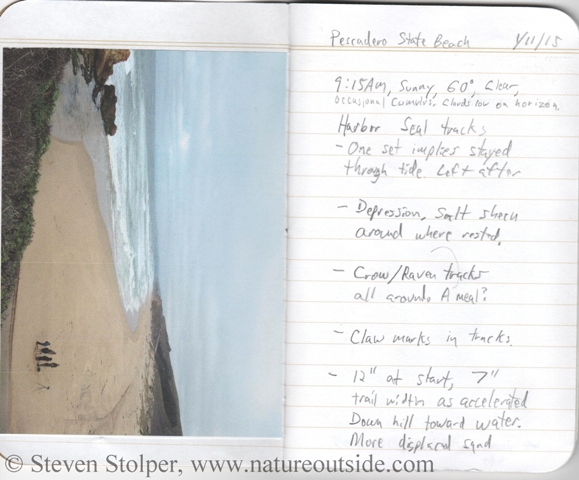
Sometimes I break format because I’m pressed for time or am feeling a bit lazy. It’s OK! Do whatever works for you.
After my hike, I print out my pictures on a color ink-jet printer. Then, I trim them to size and paste them into the right-hand pages using a craft glue stick.
Keep a Journal and Grow as a Bushcrafter
Everyone should try to keep a journal. You may discover it has enormous personal benefits. It can help you notice more on your hikes, grow your understanding of nature, and help you relive past adventures.
Do you keep a journal? Why or why not? Let me know by leaving a comment below.
Win a free leather-bound nature journal!
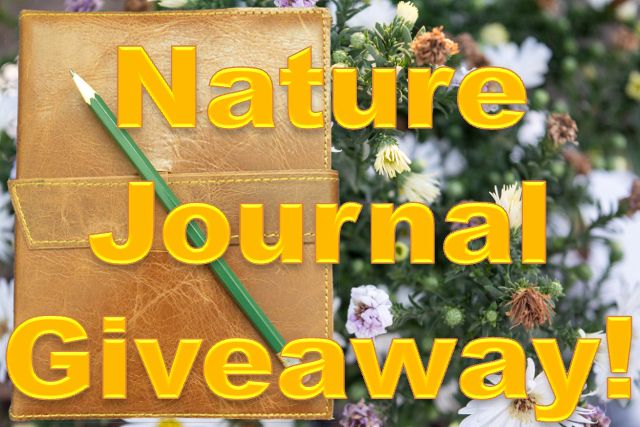
This giveaway has ended. But you can become eligible for the next giveaway by signing up for the free Bushcraft Newsletter.

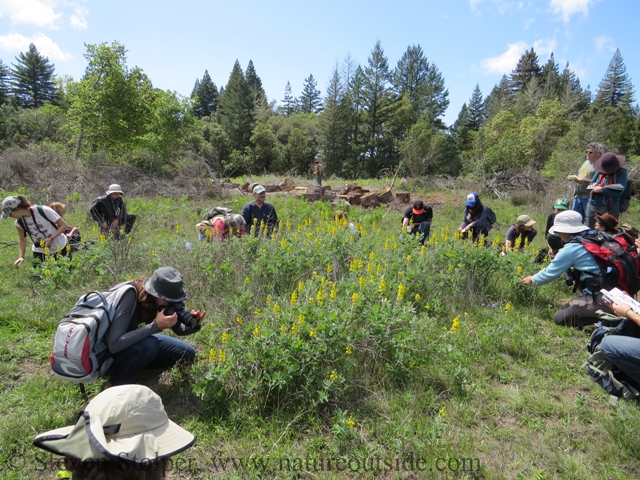


This is great, you are truly inspirational! Thanks so much for sharing, really helpful
You’re welcome, JMo! I’m glad you enjoyed the article.
Very good info here on capturing the moments of your hiking excursions! Thank you for enlightening me!
Jeanine, I’m glad you enjoyed the article.